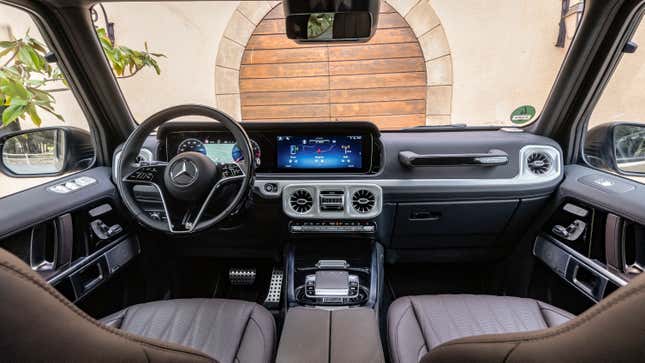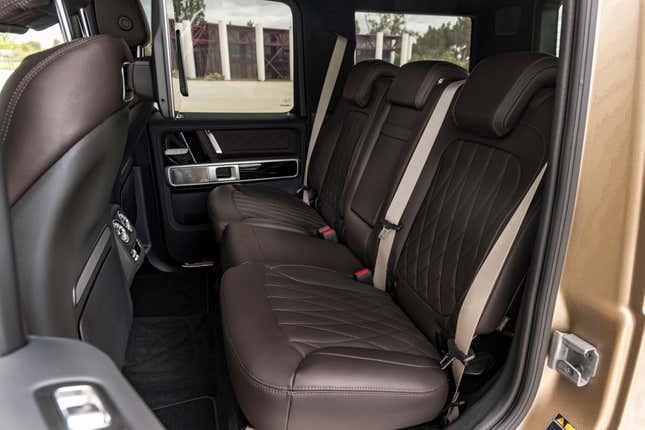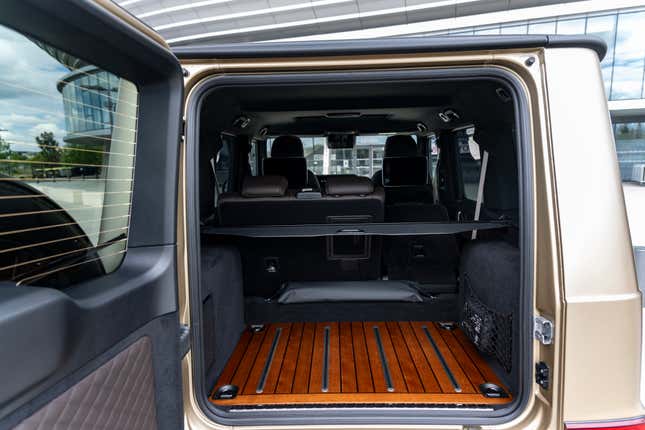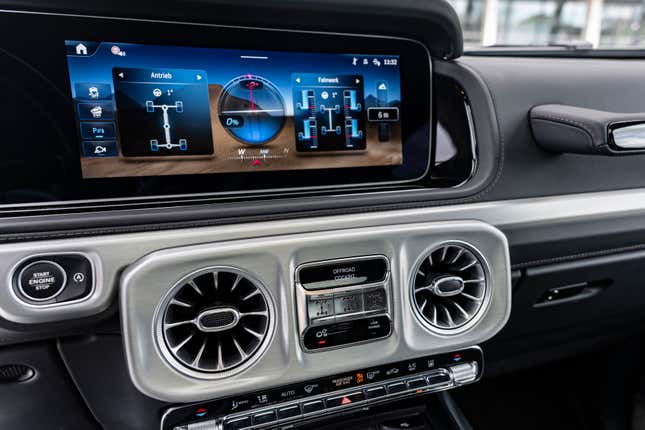Six-Cylinder 2025 Mercedes-Benz G550 Is Better But Less Desirable

Mercedes-Benz says the G-Class has the greatest powertrain variety out of its entire historical model lineup, which some might find surprising for what started out as a simple military SUV. Over the past 45 years the G-wagen has used engines with four, five, six, eight and twelve cylinders. There have been diesels and gas motors with inline and V shapes, manual and automatic transmissions, superchargers and turbochargers. Now there’s even a fully electric model, the G580 with EQ Technology. In the 24 years since the G-wagen was first officially sold in the U.S. the base model has always used a V8, but that is changing with the 2025 G550.
Is The New Toyota Land Crusier A Real Land Cruiser? | Jalopinions
The “entry-level” G is going back to its roots with an inline-6 engine, the first time a G-Class has had a gas inline-6 since 1998. Unlike G-Class engines of yore, though, the new G550 has a mild-hybrid setup in a bid to further improve efficiency. Compared to last year’s V8-powered G550 the new six-cylinder model is better to drive in every way, though in the process it’s become a bit less desirable.
Full disclosure: Mercedes-Benz flew me to Montpellier, France, to drive the entire 2025 G-Class lineup, from this G550 to the AMG G63 and the new electric G580, along with some heritage G-wagens. We stayed at a couple wineries, ate excellent food and got rained on and muddy. It was great.
Photo: Mercedes-Benz
On paper the new G550 is the clear winner versus the outgoing G550. Replacing the old twin-turbo 4.0-liter V8 is Mercedes’ now-familiar turbocharged 3.0-liter inline-6, which is augmented by a 48-volt integrated starter-generator that adds 20 horsepower and 148 pound-feet of torque. The new G550 has a total of 443 hp and 413 lb-ft, an increase of 27 hp over the old V8 but a decrease of 37 lb-ft. Peak torque is made between 1,950 and 5,500 rpm, versus a peak range of 2,250 to 4,750 rpm in the V8, and towing capacity has gone up ever so slightly. Mercedes says the new G550 will hit 60 mph in 5.3 seconds, 0.3 second quicker than the V8. We don’t yet know exactly how much the G550 weighs, but it should be a bit lighter than the old one, and it will certainly get better gas mileage too.
Behind the wheel the inline-6 is lovely and perfectly suited to the G-Class. Power delivery is extremely smooth and shifts from the 9-speed automatic transmission are basically imperceptible. It definitely feels quicker than the V8 did; the real-world 0-to-60 time is probably closer to 5 seconds flat. The boost from the auxiliary compressor is noticeable especially when passing on the freeway, and it makes the engine’s stop-start totally seamless, a massive improvement over the loud and shuddery operation of the V8’s. Adaptive suspension is now standard and has been returned for better body control and less pitch and roll. The steering also seems a bit more direct, and it has nice weighting in Sport mode.

Photo: Daniel Golson/Jalopnik
Where the new G550 loses out is in overall character. Don’t get me wrong, the inline-6 is a nice-sounding engine. It purrs in Comfort mode and gets throatier in Sport, with some fun turbo whirrs and whistles, and despite not having side-exit exhaust like the AMGs, it emits a good deal of six-cylinder noise for passersby. It just doesn’t hold a candle to the brash V8, with its bellowing exhaust note that sends rumbles through the entire car. Sure, the new G550 is quicker than the old one, but it’s not as exciting or rewarding to drive like an asshole around town. It has the same phenomenal driving position and visibility as the old G550, and the driving characteristics are intact, but it doesn’t have as much of a soul.
I think it would’ve been cooler for Mercedes to give the G550 the six-cylinder plug-in-hybrid setup that’s found in cars like the S580e. In the S-Class the inline-6 is paired with a 28.6-kWh battery pack and a 148-hp electric motor for a total of 510 hp and an electric range of 46 miles. A battery that size probably couldn’t fit within the G’s frame, but still, that increased electric punch and a bit of EV-only range would be really nice. Or, alternatively, the G550 should at least be offered with an AMG exhaust package, as the performance versions of the inline-6 sound much heartier.

Photo: Daniel Golson/Jalopnik
Exterior design tweaks are extremely minimal, basically amounting to a new four-bar grille that’s a huge improvement and a redesigned front bumper with rounded intakes. There are new colors and wheel designs — including the phenomenal new 19-inch monoblocks you see above — and a host of option packages that add things like black fender flares, color-matched spare tire covers, G logos on the door handles and even a Schöckl design package that puts a repeating script and topographical map in the side strips and other elements. Mercedes says more than 20,000 paints are offered through its Manufaktur program, with over one million possible spec combinations in total. I’m particularly fond of the Kalahari Gold Mango example I drove, which had a dark espresso interior with gold seatbelts and a cherry wood floor.
Mercedes reduced the button clutter, redesigning the climate control panel beneath the diff locker buttons. You can now get heated and cooled cupholders, perfect for holding your $13 latte while off-roading, and the new G-Class has Mercedes’ latest steering wheel designs with touch-capacitive buttons, which I actually like. The G-wagen finally comes with Mercedes’ 64-color ambient lighting, with some new light strips in the dash and optional illumination for the air vents and the roof loudspeaker of the standard Burmester 3D surround sound system. Said sound system now has Dolby Atmos, and it sounds fantastic. Aerodynamic tweaks developed for the EV have made the cabin a quieter place to be at high speeds, a very welcome upgrade, though there’s still plenty of wind noise.

Photo: Mercedes-Benz
By far the biggest upgrade is the G550’s tech. Gone is the old Comand infotainment system, which could only be controlled by an outdated knob and button array on the center console. While great when it first came out, and it did at least have Apple CarPlay, in 2024 that system just is not it. The 2025 G-Class uses a pair of 12.3-inch screens combined into one display like before, but the center screen is now a touchscreen, and the car is running the much newer and much better MBUX software.
Apple CarPlay and Android Auto are now wireless, and the G-Class has new USB-C ports throughout. A touchpad replaces the old knob on the center console, with a simpler set of buttons around it, and having that paired with the screen’s touch capability makes navigating the system a breeze even in motion. The MBUX menus are simpler and the displays are much more customizable, plus you get awesome augmented-reality navigation and Mercedes’ voice assistant, which has 20 G-specific voice commands. A rear-seat entertainment system with a pair of 11.6-inch touchscreens is optional, as is a dashcam.

Photo: Mercedes-Benz
Previously relegated to only the G63, the G550 now gets a surround-view camera system as standard, which also brings a “transparent hood” function when off-roading that projects a virtual view of what’s underneath the front end. Also new to the G-Class are active steering assist and route-based speed adaptation for the adaptive cruise control system, and active emergency stop assistant. Other standard safety features include automated emergency braking, active lane-keeping assist, blind-spot assist, parking sensors and traffic sign recognition.
Perhaps the most enticing change is the addition of keyless entry, which has never been offered on a G-wagen before — when this new generation of G was revealed, Mercedes’ engineers said they hadn’t figured out how to make it work while retaining the solid thunk of the door latch and the bolt-action door lock noise and feel that have always defined the G-wagen. One of the G-Class’ engineers explained to me that the G already gained electronic locks a few years ago without anyone noticing, which was a major step, but adding keyless required subtly redesigning the door handle to be thicker so it could accept the necessary electronics and sensors. The keyless system will be standard in the U.S., and it works for the G-wagen’s swing-out tailgate, too.

Photo: Mercedes-Benz
For the vast majority of G550 buyers, the new model will be worth upgrading to if they already own the old one or worth finally writing a check for if they don’t. For that subset of G-Class buyers that are true enthusiasts of the model, the loss of the V8 might be a turn-off. Luckily, you can still buy an AMG G63 with the V8 engine, now with its own mild-hybrid setup that makes it rowdier than ever. But the biggest competition for the G550 is the electric G580, which is better than its gas counterparts in basically every way, both on-road and off-road. The G580 EV probably won’t carry much of a price premium over the G550 either, and it has a much greater personality. I think the electric G is the no-brainer choice.
Regardless, it’s great that Mercedes will continue to offer all three G-Class models (plus diesels in other markets.) The production facility in Graz, Austria is flexible enough to accommodate for any sort of production split between the three, meaning if demand becomes higher for any one powertrain then the plant can adjust production accordingly, though Mercedes is keen on keeping total production much lower than the actual demand. The G550 is already a rare bird in the U.S., allegedly making up as low as 15 to 20 percent of total production against the G63, and with the EV and updated AMG that number could shrink further. It’s the most “if you know, you know” model in the G-wagen lineup, and for that it’ll always have fans.

Photo: Mercedes-Benz

Photo: Mercedes-Benz

Photo: Mercedes-Benz



